|
FEATURE STORY
Pot-hunting in Mishima
Carnival Fun, But Buyer Beware !
By ROBERT YELLIN
Return to Fairs/Flea Markets Top Menu
|
|
|
|
|
|
|
|
|
|
|
|
|
|
Top to Bottom
Outdoor Sign, Shinto Gate, Grand Shrine, Market Scene
|
|
The signs were everywhere around town. "National Giant Ceramic Market" they proclaimed. For most people in Mishima -- that's where e-y Net is located -- I would imagine that this appeared to be a HUGE event with a chance to view and purchase the finest in Japanese ceramics.
Well, things are not what they always appear to be -- as we shall find out -- but hey, I figured, let's go take a look and do a little photo shoot. Besides, the Grand Shrine of Mishima, where the event was held, is only a five-minute walk from my office. As you might be able to gather I've been to these ceramic markets before.
I love to go to art markets, not so much ones that offer only newer works though, but the antique ones. To any dealer at either market, I am just another gaijin (foreigner), and they always talk me up.
" Mr.Gaijin, oh, you're holding a YU-NO-MI -- Japanese green tea cup, from Bizen, yes, Beeeee-zen."
I usually reply with a dumbfounded 'ah-so' and realize that we all have to begin somewhere in our yakimono training. Actually for me it was at such events many moons ago, and also at my local supermarket, where I bought my first 250-yen guinomi. Lo and behold they were being sold at the Mishima market, as well as dozens upon dozens of small porcelain rice bowls.
That was not all there was. The ever-inventive Japanese ceramic world has come up with some fairly funky things in the past as I've noted before and I found a few new ones this time around. I spied some shamoji, which are spatula-like utensils used to scoop rice out of a rice cooker, a few night-lights lit up one booth, and some pink frogs meant to bring luck rested in a basket (see below photos).
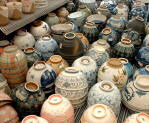 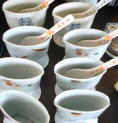 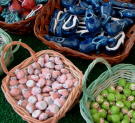
Left to Right: Rice bowls, Shamoji, Ceramic Frogs
Actually, the frogs are supposed to bring money, in Japanese frog is kaeru and a play on words also makes the same word mean "come" -- so, people put the little amphibians in their purses hoping that some money will show up out of the blue!
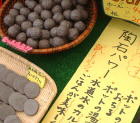 My favorite odd item though were these ceramic balls. A sign next to them said '"Tohseki pa-wa" or "Ceramic stone power!" It then went on to explain the magical powers that come out of placing the tohseki in your hot water heater or rice cooker making the water or rice taste better and also imparting some ki or energy. "Step right up!." My favorite odd item though were these ceramic balls. A sign next to them said '"Tohseki pa-wa" or "Ceramic stone power!" It then went on to explain the magical powers that come out of placing the tohseki in your hot water heater or rice cooker making the water or rice taste better and also imparting some ki or energy. "Step right up!."
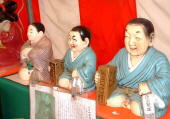 When I walked into the tent compound I was greeted by these large dolls in one booth. I found their expressions comical and their exposed posture just a bit too risque. I wonder how one would look sitting so gaily in a reserved tokonoma. But then again, I'll let that thought pass. When I walked into the tent compound I was greeted by these large dolls in one booth. I found their expressions comical and their exposed posture just a bit too risque. I wonder how one would look sitting so gaily in a reserved tokonoma. But then again, I'll let that thought pass.
The booths were mostly divided up by pottery locations. There were pots from Arita, Karatsu, Bizen, Mino, Kyoto, Hagi, and a few other "mystery" styles. The vendors did their best to set up flashy displays for the mostly mediocre mass-produced wares they sold. I was almost a bit embarrassed that this event was being held and that the average Japanese doesn't even know that much about their wonderful ceramic culture. I felt like setting up a soapbox and lecturing the shoppers on the finer points of Japanese pottery -- now that would have been a sight!
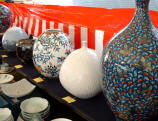 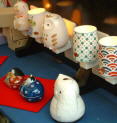 
Left to Right: Arita Pots, Various, Yakishime Tokkuri
Maybe I'm being a bit too harsh with that criticism. Not everybody finds value in drinking green tea, for instance, in a hundred dollar or more yunomi. Yet, it's not just the price but also the value in the sustenance found in fine handmade ceramic works that is priceless. A good piece will cost very little if used over many decades. I mean what's the point in selling these innocent folks underfired yakishime works like these tokkuri or Bizen chawan.
ALL of the Bizen was second-rate at best and many had artificial 'goma' on them that reminded me of plastic. The chawan were spiritless as well.
I checked out all the booths, including the ones selling non-ceramic goods, like $8000 tea chests and $3000 hibachi-all were modern. I also found some worthless hanging scrolls and all sorts of ceramic gods, demons, spinsters, and fools.
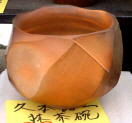  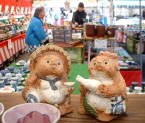
Left to Right: Bizen Chawan, Pots and Scrolls, Ceramic Tanuki
On the bright side, there were a few nice Arita pots and some not-too-bad Hagi chawan by veteran Shibuya Deishi -- one can see his works for sale on some Internet auction sites. Sitting next to the Hagi works were two modern vases by Kato Shigemi. I also met the Karatsu potter Takiguchi Shinichi who did some decent work including some nice hakeme yunomi.
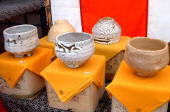 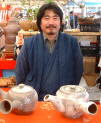
Left to Right: Hagi chawan by Shibuya Deishi; Takiguchi Shinichi
The event travels the country and stays about two weeks in any one location. This was only one of many and I'm sure as one travels around Japan more likely than not you'll be able to come across such a ceramic market. That is if you want to, just remember that I gave you the lowdown. It was like a 'ceramic carnival and that's how I enjoyed it.
Outdoor market scene
FOR MANY MORE PHOTOS, CLICK HERE
|